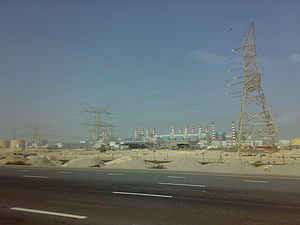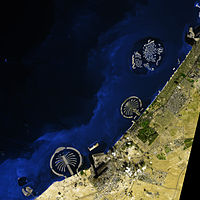Jebel Ali power plant and seawater desalination plant
| Jebel Ali power plant and seawater desalination plant | |||
|---|---|---|---|
| Some chimneys of the power plant | |||
| location | |||
|
|
|||
| Coordinates | 25 ° 3 '35 " N , 55 ° 7' 2" E | ||
| country |
|
||
| Data | |||
| Type | Combined cycle power plant | ||
| Primary energy | Fossil energy | ||
| owner | Dubai Electricity and Water Authority (DEWA) | ||
The Jebel Ali power plant and seawater desalination plant ( Arabic محطة جبل على, English Jebel Ali Power and Desalination Plant ) is a gas and oil-fired combined cycle power plant combined with a seawater desalination plant southwest of Dubai in the United Arab Emirates .
The power plant complex, consisting of nine individual plants, extends over a length of more than three kilometers along the coast of the Persian Gulf between the port of Jabal Ali and the Jumeirah district . On the water side, the power plant is located between the artificial islands of Palm Jumeirah and Palm Jebel Ali , a good 40 km southwest of Dubai.
The facility, which is operated by Dubai's Energy and Water Authority (Dubai Electricity and Water Authority) , covers most of Dubai's energy and water consumption. With an installed capacity of 8.6 gigawatts, it is the largest gas-fired power plant. The world's largest seawater desalination plant can desalinate 2.135 million m 3 of seawater per day ( as of 2015), which corresponds to 470 million imperial gallons per day (MIGD).
The primary fuel used is natural gas or associated gas from oil production; Diesel and heating oil are used as a reserve . Since Dubai's own oil / gas production is insufficient, fuel is imported via pipelines from the neighboring emirates (especially Abu Dhabi and Sharjah ) and other Gulf countries (especially Iran and Qatar ).
With one exception, the seawater desalination plants work according to the multi-stage flash evaporation process , i.e. they use the waste heat from the power plant. Only one system uses the reverse osmosis process .
Structure and technical data
The system complex consists of the following subsystems:
| block | Construction year | Electric power (MW) |
Desalination (MIGD) |
annotation |
|---|---|---|---|---|
| D. | 1976 | 1027 | 35 | Formerly a pure steam power plant, converted into a station wagon from 1995 |
| E. | 1976 | 616 | 25th | |
| G | 1980 | 818 | 60 | 4 x Siemens GT |
| K1 | ? | - | 20th | |
| K2 | 2002 | 918 | 40 | 3 x (Siemens GT V94.3 + Alstom HRSG) + 2 x DT (steam turbine) |
| L1 | 2005 | 969 | 70 | |
| L2 | ? | 1393 | 55 | |
| M. | 2013; 2019 | 2185 + 700 | 140 | 6 x (Siemens GT 4000F + Doosan HRSG) + 3 x Alstom DT 2 x (Siemens GT 4000F + HRSG) + Siemens DT |
| ? | - | 25th | Reverse osmosis system | |
| total | approx. 8.6 GW | approx. 470 MIGD (= 2.135 million m³ / d) |
See also
Individual evidence
- ↑ a b Power & Desalination Plants Installed Capacity 2015
- ↑ Middle East Pipelines map on www.theodora.com
- ^ Repowering Jebel Ali D on www.powergenworldwide.com
- ↑ Jebel Ali K2 on www.powergenworldwide.com
- ↑ https://www.nsenergybusiness.com/news/dewa-m-station-extension-project/
- ↑ https://www.dewa.gov.ae/en/about-us/media-publications/latest-news/2017/04/jebel-ali-m-station-adds-to-dewas-growing-list
- ↑ Jebel Ali M-Station on www.power-technology.com


